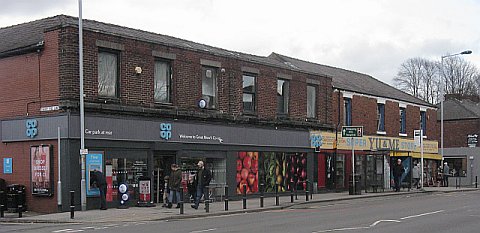Hannah Winbolt and her Family
A Davenport history feature, written by Charlie Hulme
Davenport Station home | Index to History pages

In 2018, 100 years since property-owning women over 30 years old were first able to vote in Parliamentary elections. Stockport Heritage Library mounted a very interesting display on the story of Stockport-based campaigner Hannah Winbolt.
Hannah kept a scrapbook with records of her achievements, which was acquired by Stockport Library in 2015; the Librarians kindly allowed me to study the book after it had been removed from display.
On this page we try to fill in the family background to her activities, and also explore the Winbolt family into which she married, and their legacy in Stockport. As usual in these pages, there are gaps and inconsistencies in the story: comments and contributions are always welcome.
The Winbolt Family
Winbolt is not a Cheshire name. It is thought to be a variation on the more common name Baldwin, believed to mean 'brave friend'.
The Winbolt family of Great Moor was established by William Winbolt, born around 1817 in the area of east London commonly known as Spitalfields; his wife Sarah was also born there. The area is known to historians as the place where silk-weaving was first brought to Britain in the 1680s, by Protestant families from France fleeing religious persecution following King Louis XIV's revocation of the 1598 Edict of Nantes which had granted them religious freedom in the predominant Catholic Country. By 1687 it was being reported that over 13,000 'Hugenots' had settled in London. (Experts differ on the origin of the word.)
William Winbolt and his wife Sarah were hand-loom silk-weavers, probably following a family tradition. In the 1840s they moved out of London, to Braintree in Essex, which had been a silk manufacturing area since a factory was established by George Courtauld - himself a native of Spitalfields - in the 1790s. The last silk mill there, Warner's, closed in 1990. (Courtauld's grew to be an industrial giant over the next century.)
It was around 1850 that William moved his family again, to Great Moor where they are recorded in the 1851 census. The family continued to grow: the 1861 census lists sons William (18), John (14) George (13), James (8), Thomas (6) and Robert (8 months) as well as daughters Ann (23), Sarah (17), Mary (15), Eliza (3) and Jane (2). Two more daughters, Martha and Emma, were born before William died in 1870 in his early fifties. His widow Sarah died in 1895, by which time her eldest sons had achieved a fairly comfortable life for the family.
Master Builder
Of particular interest, in addition to John Winbolt (see main article) is William's eldest son William Winbolt (Junior), who made a large contribution to the landscape of the Davenport area. He married by 1871 and was living with his wife Martha in their own cottage in Great Moor - no far from from Hannah Oldham's house - with their one-year-old daughter. They were still a silk-weaving family at that time, but William had other ambitions: he trained in the building trade, and by 1881 was describing himself as a 'Master Builder.'His address in 1881 was 21 Buckingham Street, Heaviley, and daughter Elizabeth had been joined by a son, Harry. The firm flourished, erecting many of the buildings that we know in the Davenport area today. By 1891 they had moved to a larger house, 62a Bramhall Lane in Cale Green, and by 1901 a still-larger one at 207 Bramhall Lane, by which time Harry, aged 25, was a partner in the firm. They established business premises on Winifred Road, off Bramhall Lane, on the site of the present electricity sub-station.
| HOUSE, in Garner's Lane, Davenport,
at liberty March, two entertaining rooms, three
bedrooms, bath, w.c. &c., cellared throughout,
£22 10s., also one in Kennerley Road. Winbolt, 162
or 207 Bramhall Lane, Stockport |
An advert from the Manchester Guardian, 1907. £22.10s would be the annual rent.
By 1911 William and Martha were sharing a large house at 2 Devonshire Park Road, Davenport with their daughter Elizabeth and her husband Ernest Brown, an engineering draughtsman. William died in 1917, leaving an estate worth £23,145. Elizabeth Brown died in 1946, at 'The Bungalow' 51 Egerton Road, Davenport.
Harry Winbolt carried on the business after his father's death. In 1911 and in 1923 he was at 10 Elmfield Road, Davenport, possibly also a Winbolt product. By 1938 he had retired, and when he died in 1970 he and his wife were living in Bakewell, Derbyshire.
Among the many local buildings built by the Winbolts and still prominent today are 205 to 231 Bramhall Lane - all were built as houses and were later converted to shops or business premises. In 2018 No.207 serves as the Debra charity shop.
Winbolt siblings
Of the ten other siblings of William and John, we know that
George died when only 19 years old. James also died young,
in 1867.Thomas Winbolt married, raised a family in the area, and continued to work as a silk weaver. He also invested in local property. It appears that some time after 1901 he emigrated to America.
Eliza, Robert and Emma all worked as silk weavers, and never married. The 1911 census shows them living together at 365 Buxton Road, on the corner of Winbolt Street. Their record was written for them by a neighbour, suggest they were not fully literate. Emma, the youngest, died there in 1938. (In 2018 the cottage forms part of the 'Yu & Me Store'.)
Note on Silk Weaving
Hand loom weaving seems to have survived longer than in the cotton industry, due perhaps to the fragility of the material which made design of power looms difficult. Some of this writer's forbears were silk weavers in the Cheshire village of Kettleshulme. It was often viewed as a supplement to a family's income, as the loom did not occupy a lot of space, did not require great manual effort, and 'many women can spare one or two hours each day.'Nothing appears to has been published about the silk weavers of Great Moor, but a look at the 1871 census of the Branhall side of the main road between Woodsmoor Lane abd Bramhall Lane reveals 46 people identified as silk weavers, The the nearby village of Hazel Grove was home to many home-based silk weavers; houses were constructed with 'loom shops' in which they could work on their looms, either on an upper floor, in a cellar, or in a building at the rear.
Many of these houses have been demolished, some fortunately having been photographed for posterity, but one or two survive today with their loom shops in other use. A few hand-loom weavers were still working in the area in the late 1920s.
The Oldhams and the Winbolts in Great Moor do not seem to have had custom-built houses, however. Old maps show few extensions to the old cottages; the houses in Store and Winbolt Streets, which all survive in 2018, have small outbuildings at the rear but are otherwise identical to the hundreds of terraced 'by-law' houses still doing good service.
One Great Moor loom shop survived at No. 356 Buxton Road, converted to a living room for the live-in owners of the house when converted to a shop. This had been the workplace of Bradford Hallworth and his family of weavers.
It is also possible that the weavers worked in communal buildings in the neighbourhood; further research on this subject is needed.
Sources
Hannah Winbolt's scrapbook and other resources in Stockport Heritage Library.'Silk Weaving' in British History Online, extracted from William Page (ed) A History of the County of Middlesex: Volume 2, p.132-137. London: Victoria County History, 1911.
Sir Frank Warner, The Silk Industry of the United Kingdom: its origin and development. London: Deane's, [1921]. Full text available online.
Elizabeth Crawford. The Women's Suffrage Movement in Britain and Ireland: A Regional Survey. Abingdon: Routledge, 2006.
T.W. Gough. Stockport Great Moor Co-operative Society Ltd. 1831-1931. A Centenary History - as quoted in the Archives Hub. (Does any reader own a copy of this book?)
Heather Coutie. Hazel Grove and Bramhall (Images of England). Stroud: Tempus Publishing, 1997.
Norbury Churchyard Grave Records
Mark Fynn's Stockport Postcards
Ancestry.co.uk, The British Newspaper Archive, The Guardian archive, the Land Registry online.
Hannah Winbolt on the GMstories blog and a Wikipedia page.
Thanks
We are grateful to Stockport Heritage Library staff for their research, the exhibition which drew our attention to the story, and their assistance in allowing access to the scrapbook.Thanks to present-day women's equality campaigner Diane Coffey for sharing her research and references.
Contributions are very welcome:
info@davenportstation.org.uk
Hannah Winbolt: Women's rights campaigner
Hannah Winbolt was born Hannah Oldham in 1851 in a cottage in Great Moor, Stockport; due to its location on the west side of the Stockport to Buxton road, the cottage was at that time part of Bramhall township, the estate of the Davenports of Bramhall Hall. Three families of Oldhams occupied three adjoining cottages, headed by Peter Oldham, a porter; William Oldham, a carrier; and Henry Oldham, a silk weaver; Hannah was the youngest of three children of William and his wife Esther. Members of all three families were engaged in the hand-loom weaving of silk, a common occupation at that period in the area. Hannah received a part-time education at a small local school only to the age of eight, before having to start work: a subject which she returned to in her adult campaigning.
The Oldham brothers were well-respected citizens: Peter and Henry were founder committee members of the Stockport Great Moor Co-operative Society, which joined with a society founded in 1831 and began with a small shop converted on the ground floor of a cottage. According to a history of the Society written in 1931, in December 1876 a plot of land was leased at the corner of Cherry Tree Lane and Buxton Road to build a new grocery store (353 Buxton Road) and cottage[s]. In 1884 a butcher's shop was opened and in 1886 the grocery store was extended.By 1861 the three Oldham families were still in their three cottages, but Peter Oldham is described as a 'farmer of 21 acres.' It's hard to establish the exact location of these buildings, or the 21-acre farm, as the census descriptions are vague. Hannah, now aged 10, was described as a 'nurse'. Hannah's elder sister Sarah was present; she was already a widow at the age of 21.
By 1900 the society was operating in drapery, boot and shoe repairs, had acquired a watch dog and had become a member of the Co-operative Union. The view above, a detail from a pre-1905 Bullock Brothers postcard, shows the store , across Cherry Tree Lane from the Traveller's Call inn. Branches were opened on Cherry Tree Lane and in Woodsmoor at 89 Moorland Road. The society continued to develop and began trading in coal in 1907, acquired further land in 1908 and in 1927 there was a complete reconstruction of the premises. When the society celebrated its centenary in 1931 they had over 1000 members.
Despite many mergers and changes over the years, in 2018 the enlarged store on the corner of Cherry Tree Lane is still in business as a Co-op. The frontage shows the result of the 1927 reconstruction.
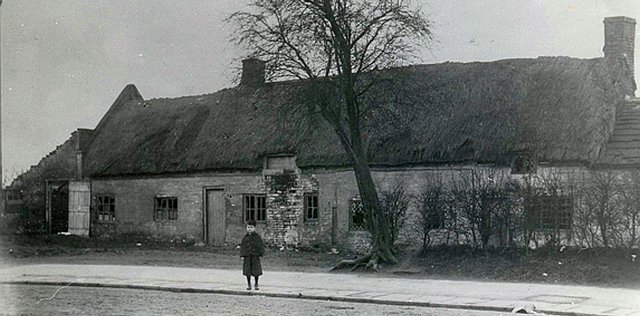
This old picture is said to show long-lost 'old thatched cottages in Great Moor' - one of which, we believe from study of tithe maps and census records, may have been the home of the Oldhams in 1871. By that date we find that William had become a coal-hewer; his wife Esther and daughter Hannah - the only one of their children still at home - were silk weavers by hand, having been taught, according to a newspaper biography, by Hannah's uncle Henry. Living with them was William's granddaughter Charlotte Horsefield who at age 10 was working as a bobbin-winder for the weavers.
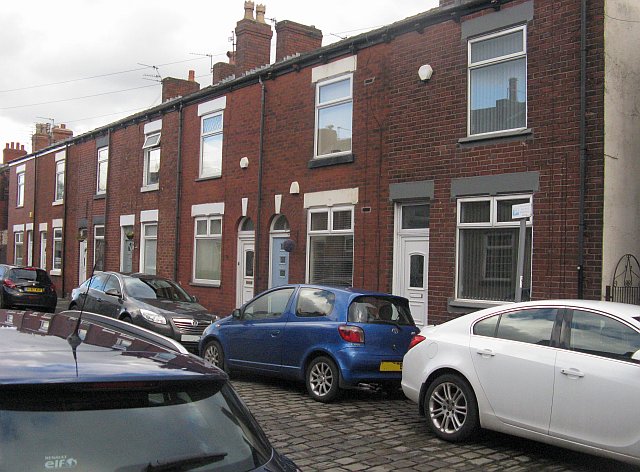
In 1878, John Winbolt (whose middle name O'Connor appears on various documents - it was common for fathers to give their sons middle names honouring fieids of colleagues) ) leased from Ephraim Hallam a plot of land on the Stockport side of the Main Road, on which was created Store Street, and a row of cottages built on what became became Store Street. The picture shows the terrace largely unchanged - apart from the cars, doors and windows - Store Street in 2018, from no.2 (nearest the camera) to 14; the original stone 'setts' still form the road surface.
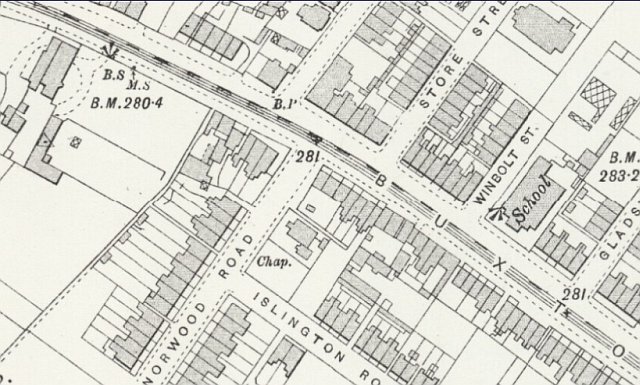
This map from c. 1895 shows the Great Moor area. The extensions to the co-operative store on the corner of Cherry Tree Lane are evident. 'B.P' marks a boundary post, which still stands in 2018, by the side of the Traveller's Call inn.
After William Oldham's death, Esther, Hannah and Charlotte moved to a house at 10 Store Street. In 1874 Hannah married silk weaver John O'Connor Winbolt, son of William Winbolt and they set up home at 12 Store Street. They never had children, and lived in various houses in the row of cottages in Store Street which were developed by the Winbolts along with a row fronting the main road, including on the corner the Co-op store and the next street to the south which still bears the name Winbolt Street. The Land Registry records that the land had been conveyed by local mill-owner and philanthropist Ephraim Hallam to John Winbolt in 1878, by which time John had retired from weaving, and apparently invested his savings in property. Ephraim Hallam owned the freeholds of a large swathe of the Great Moor and Heaviley areas.
John and Hannah were living at 2 Store Street when John died in 1919, and Hannah remained there until her death in 1928.
The inscription on the family gravestone at Norbury Church, Hazel Grove, has been recorded as:
IN MEMORY
OF WILLIAM OLDHAM
DIED 25.3.1879 AGED 46 YEARS
ESTHER
HIS WIFE
DIED 25.7.1885 AGED 72 YEARS
"THEY ARE AT REST"
JOHN
CONNOR WINBOLT
THE LOVING HUSBAND OF HANNAH WINBOLT
OF STOCKPORT, GREAT MOOR
DIED 3.6.1919 IN HIS 73RD YEAR
HANNAH HIS WIFE
DIED 12.5.1928 AGED 77 YEARS
EMMA
DEARLY BELOVED WIFE OF JAMES MARSLAND
WHO PASSED AWAY 17.4.1945 AGED 67 YEARS
"AT REST"
JAMES
THE LOVING HUSBAND OF EMMA
DIED 11.8.1962 AGED 83
"RE-UNITED"
Unfortunately, when we visited the churchyard in 2018, we found that this grave stone, with most others in that part of the churchyard nearest the church, has been removed.
Suffragist
It is said that Hannah would travel to Manchester by train with completed silk cloth to sell (in earlier times this kind of journey would be done on foot) and on one journey she met a lady on the train who asked her to sign a petition for women's suffrage. After consulting her uncle, she signed, and thus began years of campaigning for women's rights. The lady with the petition was Lydia Becker (1827-1890) a leader of the movement in the Manchester area. Clearly Hannah was inspired, and having more time to spare than a woman with children, decided to rally to the cause.
Hannah first came to media attention in the early 1890s, when she was elected to the committee of the Union of Women's Liberal Associations for the Manchester area, and founded a branch of the Association in Hazel Grove. Over the next few years she spoke at many meetings around the country, on a range topics around the rights of women and children; in every case, much was made of the fact that she was a 'working woman'. In addition to 'Votes for Women' she spoke and wrote on the education of children, housing of the poor, equal pay for women, fair trade, the Manchester Association for the Abolition of State Regulation of Vice, and even the campaigns for abolition of the House of Lords. Some of these causes have still to succeed a century later.
Her public appearances were often lively affairs. We can imagine with some pleasure Hannah lecturing her middle-class audience in her Cheshire accent. She believed in humour as a way to get her message across, especially in response to hecklers, but for some, verbal abuse was not enough. A report of a Liberal outdoor meeting in Stockport in 1893 records that:
When the chief speakers, who were Mr. Shuttleworth, of Manchester, and Mrs. Winbolt, a member of the executive committee, appeared on the platform, a number of Tory roughs threw mud and orange-peel at them. Mrs Winbolt was struck several times by these missiles.In 1894, she was nominated as a candidate for the Parish Council of Poynton-cum-Worth, but withdrew in favour of another Liberal candidate.
The following is from a South Wales newspaper of 1895, reporting on a typical conference of the National Liberal Association:
Prominent features of the meeting were the utterances of Mrs. Winbolt, of Stockport, on the subjects of registration reform and the industrial position of women. Herself an experienced workwoman, with a natural gift of eloquence and a burning desire to help women who have to earn their living by manual labour, she delighted and encouraged her fellow-delegates with her vigorous advocacy for limitations on the hours which young half-timers have to work and the placing of an equality of women with men so far as employment was concerned.On 18 February 1902 it was Hannah who was chosen by Esther Roper, who had taken over from Lydia Becker as secretary of the Manchester National Society for Women’s Suffrage, (renamed North of England Society for Women's Suffrage), to present to Parliament in Westminster a petition from 4292 Cheshire textile workers that had been canvassed by the Society.
Hannah made made a good friend of an aristocratic London supporter of the cause, Countess Alice Kearney, who sometimes stayed with the Winbolts in Store Street when speaking in the area; Hannah also stayed with Alice at her Kensington home in London. Sadly, Alice died in 1899.
Subsequently Hannah seems to have retired to some extent from public life. Her dedicated, but largely unsuccessful, efforts were taken up by the militancy of the Suffragette movement which itself originated in the Manchester area. The latest-dated entry in her scrapbook was a press cutting about 'Liberal Women and the Suffrage' from 1913. Perhaps she became disillusioned with the failure of national Liberal politicians to make progress on the suffrage issue, or was unhappy with the violent acts of the Suffragettes.
In 1910 a Women's Suffrage Society was finally founded in Stockport; the first secretary was Mary Hannah Deakin (1787-1960), daughter of a fish and chip shop tenant from the working-class Edgeley area of Stockport. She gained an Master of Arts degree, published a book The Early Life of George Eliot and established a small music school at 128 Grenville Street, Edgeley.When Hannah Winbolt died on 12 May 1928, she would only have had the vote as a property owner after inheriting her husband's property (value £710. 19s. 2d) in 1919. The Representation of the People (Equal Franchise) Act 1928, which extended the right to vote to all women in the UK over the age of 21, became law on 2 July 1928.
There is no evidence that Hannah took part in civil disobedience, or damage to property, as practised by those who called themselves Suffragettes, but it is fitting that her name and work should become more widely known in this centenary year. As such, it is pleasing that in 2018 her name connected, alongside three other Stockport women, with the planned naming of a new open space in Stockport town centre as 'Suffragette Square' and have her name inscribed on a bench. Unfortunately, this naming decision by Stockport council led to controversy as they had asked the public for suggestions, and received 1500 replies, just one of which was for Hannah, and the Council decided on the name themselves:
...after reviewing over 1500 entries, the panel decided on the name ‘Suffragette Square’ to celebrate the achievements of four Stockport women who were nominated by local people. Gertrude Powicke, Elsie Plant and Hannah Winbolt were Stopfordian women who were all active in the Suffrage Movement, predated by Elizabeth Raffald who was also a pioneering woman.Elizabeth Raffald, who lived centuries earlier and is unlikely to have given much thought to voting, seems an odd choice, as a little research could have revealed other Stockport women active in the suffrage movement.
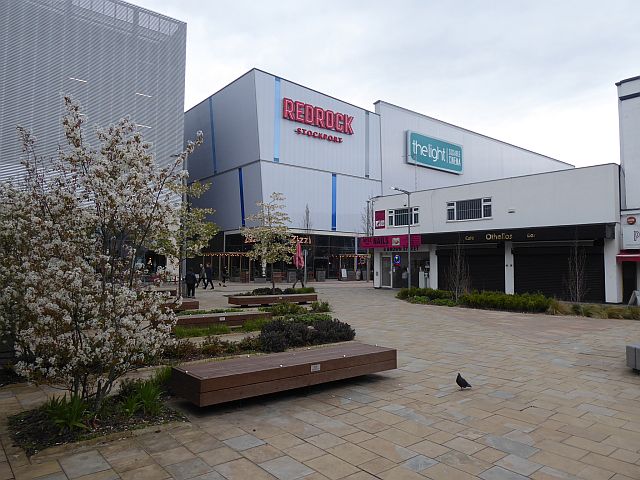
Here is the square in question, pictured in April 2019 with the new 'Redrock' development in the background. Look carefully and you can see the 'inscriptions' on the somewhat minimalist benches. There's no sign (yet?) of any plates naming the square itself.
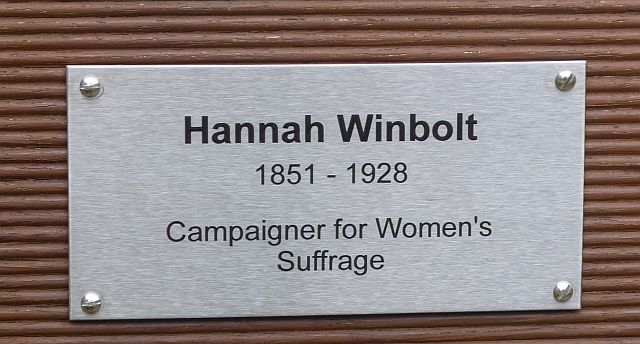
Here's a closer view of Hannah's plaque; somewhat 'low-budget' in our opinion. A blue plaque in Store Street would be a more lasting tribute.

Display in Stockport Heritage Library, 2018.
Written by Charlie Hulme, June 2018. Updated with corrections and further research, April 2019. Comments welcome at info@davenportstation.org.uk

